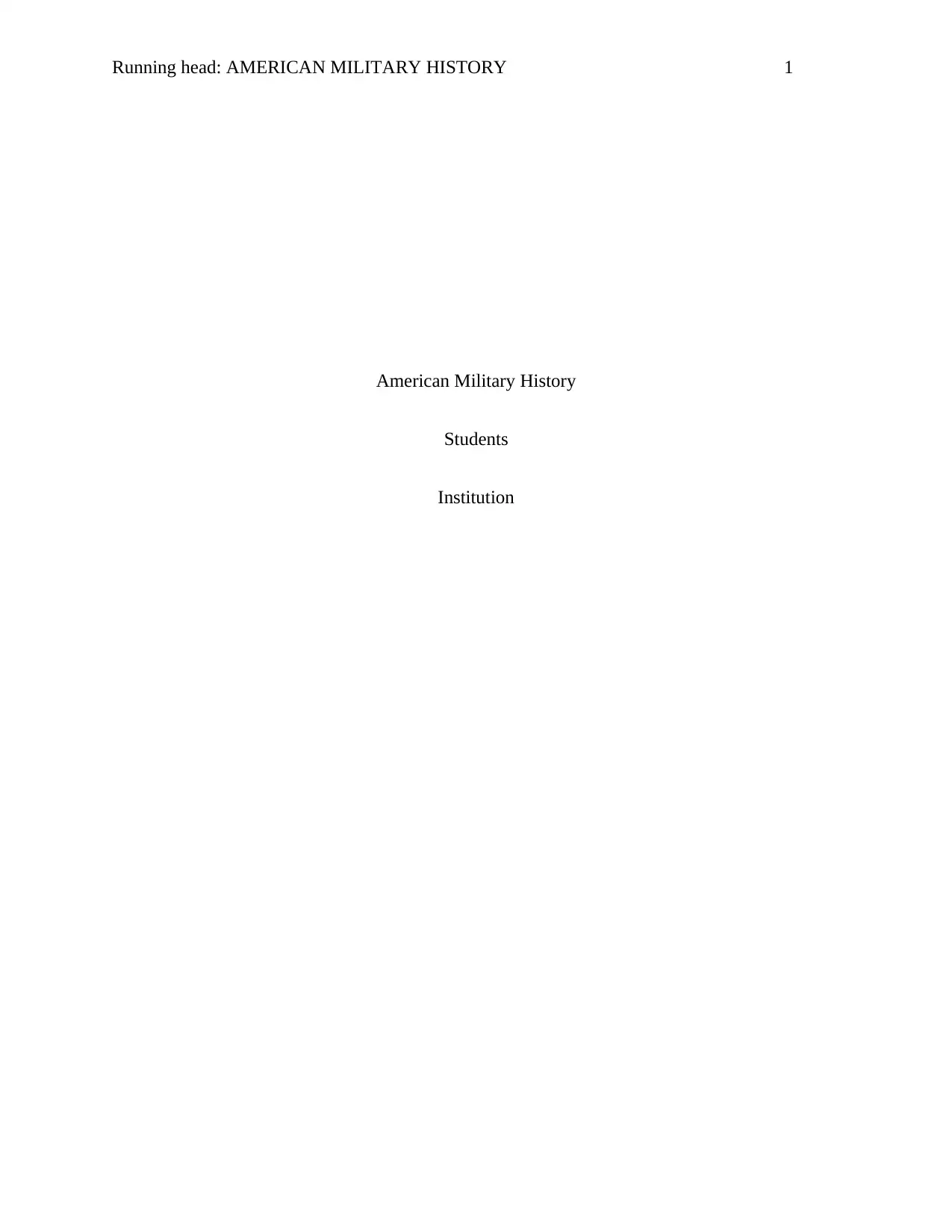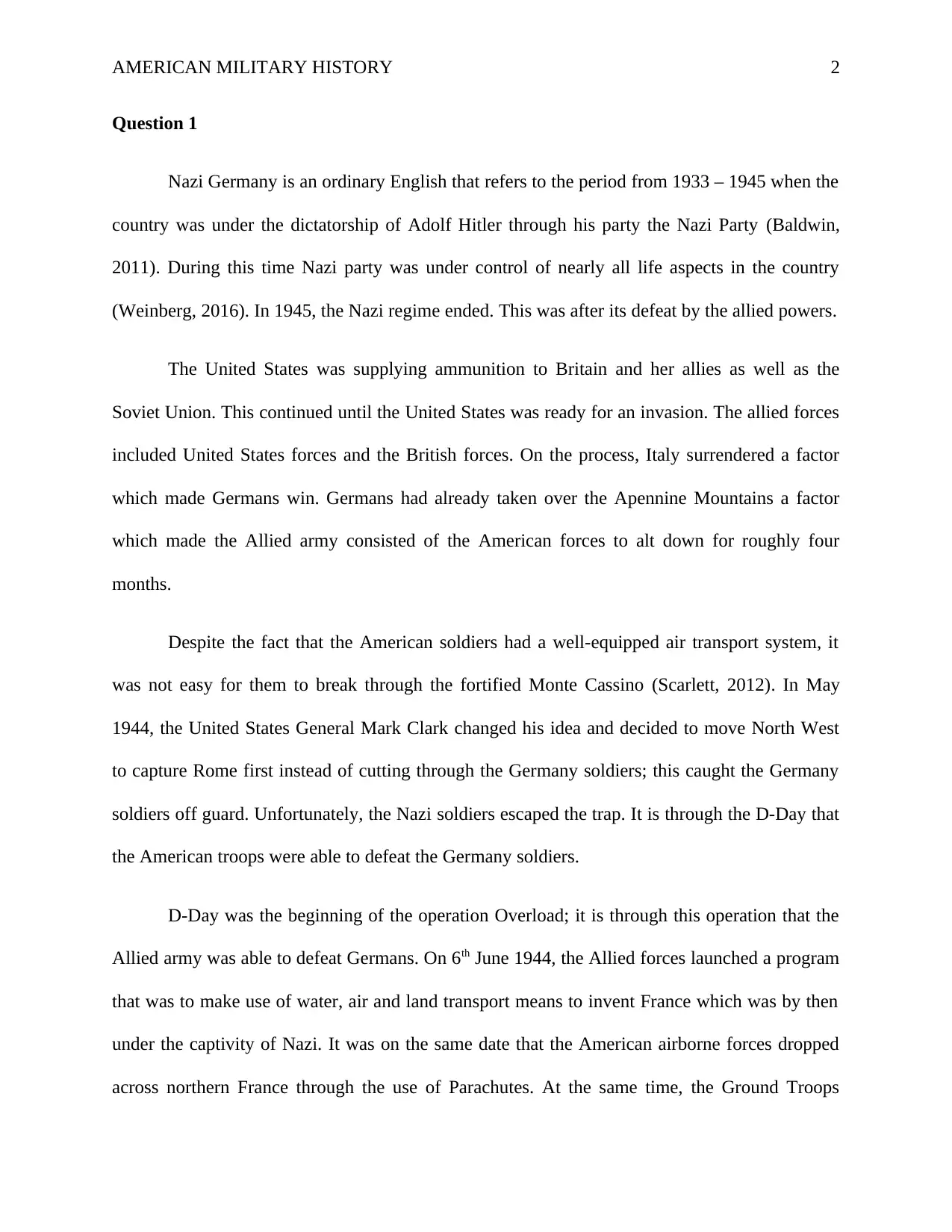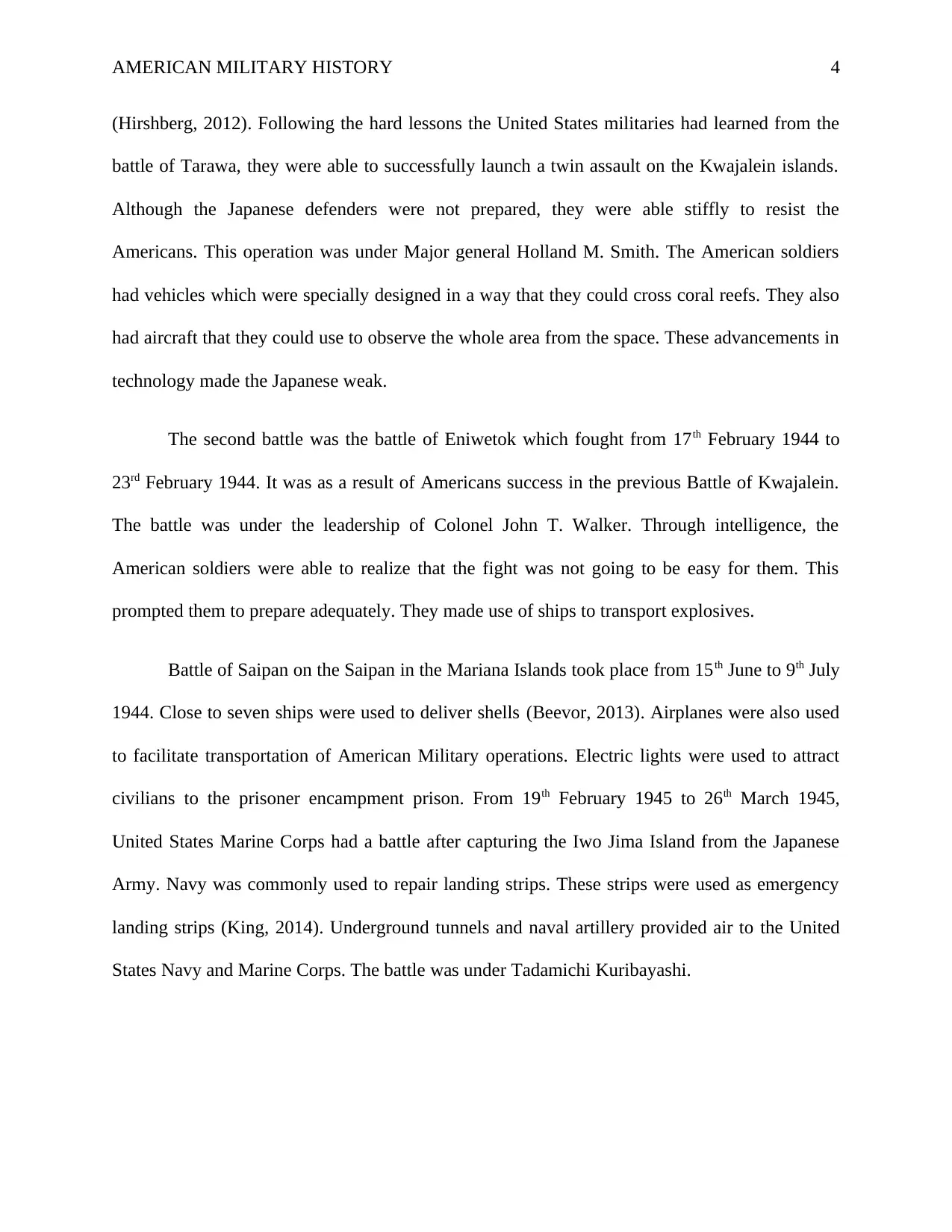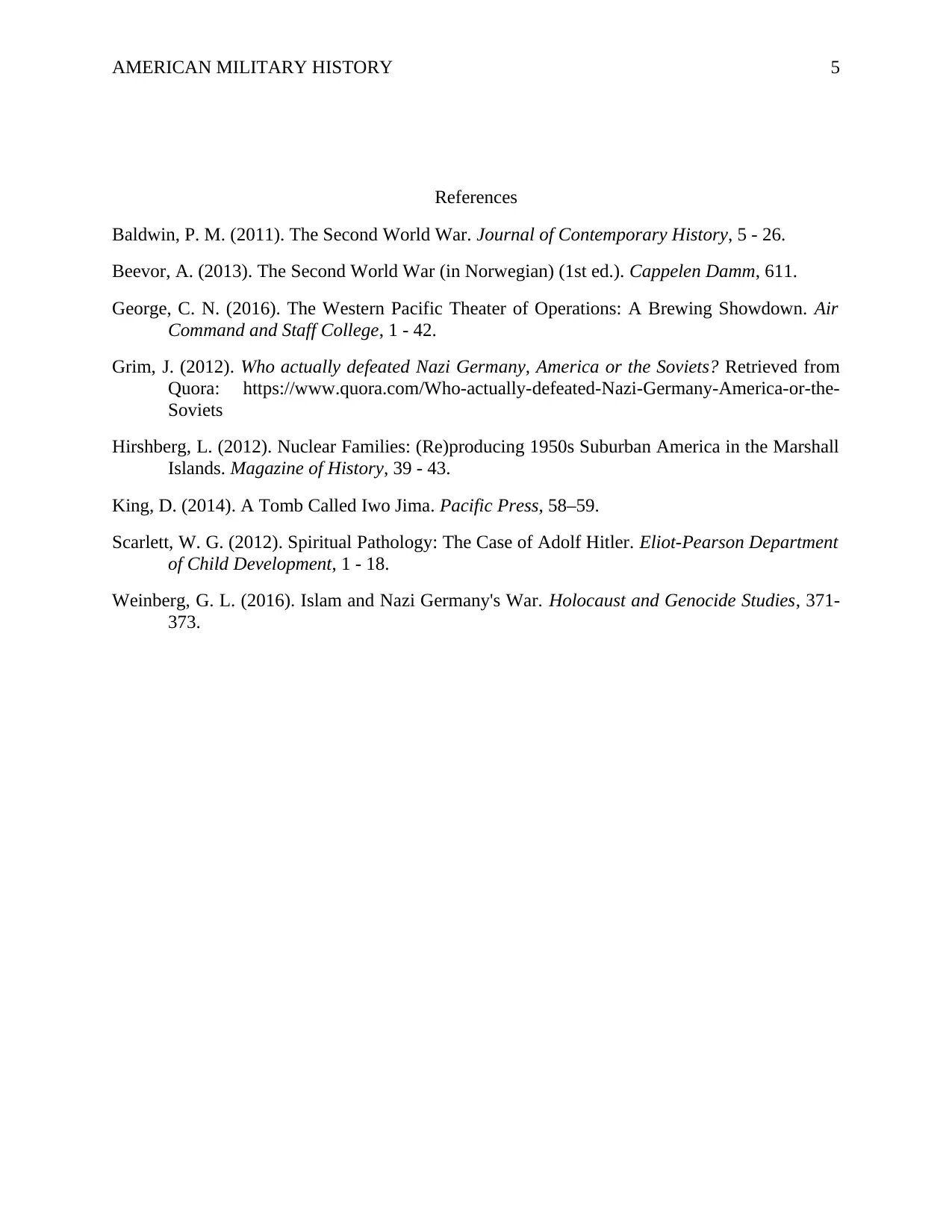WWII: US Military Operations, Strategies & Tech in European & Pacific
VerifiedAdded on 2023/06/12
|5
|1232
|491
Essay
AI Summary
This essay provides an overview of major U.S. military operations in the European and Pacific theaters during World War II. It details the defeat of Nazi Germany, highlighting the significance of D-Day and the role of new technologies in the European theater. It also examines key battles in the Pacific theater, including Kwajalein, Eniwetok, Saipan, and Iwo Jima, emphasizing the importance of technological advancements and strategic leadership in achieving victory against Japan. The essay concludes by referencing the leaders and personalities who played vital parts in these operations.

Running head: AMERICAN MILITARY HISTORY 1
American Military History
Students
Institution
American Military History
Students
Institution
Paraphrase This Document
Need a fresh take? Get an instant paraphrase of this document with our AI Paraphraser

AMERICAN MILITARY HISTORY 2
Question 1
Nazi Germany is an ordinary English that refers to the period from 1933 – 1945 when the
country was under the dictatorship of Adolf Hitler through his party the Nazi Party (Baldwin,
2011). During this time Nazi party was under control of nearly all life aspects in the country
(Weinberg, 2016). In 1945, the Nazi regime ended. This was after its defeat by the allied powers.
The United States was supplying ammunition to Britain and her allies as well as the
Soviet Union. This continued until the United States was ready for an invasion. The allied forces
included United States forces and the British forces. On the process, Italy surrendered a factor
which made Germans win. Germans had already taken over the Apennine Mountains a factor
which made the Allied army consisted of the American forces to alt down for roughly four
months.
Despite the fact that the American soldiers had a well-equipped air transport system, it
was not easy for them to break through the fortified Monte Cassino (Scarlett, 2012). In May
1944, the United States General Mark Clark changed his idea and decided to move North West
to capture Rome first instead of cutting through the Germany soldiers; this caught the Germany
soldiers off guard. Unfortunately, the Nazi soldiers escaped the trap. It is through the D-Day that
the American troops were able to defeat the Germany soldiers.
D-Day was the beginning of the operation Overload; it is through this operation that the
Allied army was able to defeat Germans. On 6th June 1944, the Allied forces launched a program
that was to make use of water, air and land transport means to invent France which was by then
under the captivity of Nazi. It was on the same date that the American airborne forces dropped
across northern France through the use of Parachutes. At the same time, the Ground Troops
Question 1
Nazi Germany is an ordinary English that refers to the period from 1933 – 1945 when the
country was under the dictatorship of Adolf Hitler through his party the Nazi Party (Baldwin,
2011). During this time Nazi party was under control of nearly all life aspects in the country
(Weinberg, 2016). In 1945, the Nazi regime ended. This was after its defeat by the allied powers.
The United States was supplying ammunition to Britain and her allies as well as the
Soviet Union. This continued until the United States was ready for an invasion. The allied forces
included United States forces and the British forces. On the process, Italy surrendered a factor
which made Germans win. Germans had already taken over the Apennine Mountains a factor
which made the Allied army consisted of the American forces to alt down for roughly four
months.
Despite the fact that the American soldiers had a well-equipped air transport system, it
was not easy for them to break through the fortified Monte Cassino (Scarlett, 2012). In May
1944, the United States General Mark Clark changed his idea and decided to move North West
to capture Rome first instead of cutting through the Germany soldiers; this caught the Germany
soldiers off guard. Unfortunately, the Nazi soldiers escaped the trap. It is through the D-Day that
the American troops were able to defeat the Germany soldiers.
D-Day was the beginning of the operation Overload; it is through this operation that the
Allied army was able to defeat Germans. On 6th June 1944, the Allied forces launched a program
that was to make use of water, air and land transport means to invent France which was by then
under the captivity of Nazi. It was on the same date that the American airborne forces dropped
across northern France through the use of Parachutes. At the same time, the Ground Troops

AMERICAN MILITARY HISTORY 3
made their safe landing across five beaches which were believed to be assault beaches (Grim,
2012). Before the day ended, the American troops had already set themselves ready to begin
their operation Overload. The landing operations were under American General Dwight D.
Eisenhower.
Germany attention was drawn through the deception campaign that was meant to weaken
and scare the Germans away from the Normandy. During this time, resources supply to aid in the
invasions had also increased substantially. American troop's superiority on space exploration
helped them to carry out an aerial pre-visit on the Germans coastal defense systems. This gave
them vital intelligence information regarding German coastal defenses. This kept Germany
troops pinned down, and the Allies made successful movements towards Germany. On May 2nd,
1945, German forces finally surrendered leading to the defeat of Nazi Germany.
Question 2
During the World War II, Pacific Ocean theatre acted as the principal theatre of the Allies
and Japan empire war. Allied powers Pacific Ocean Area command defined the Pacific Ocean
theatre. This was theatre which acted as the battle ground the Empire of Japan and the Allies.
The theatre came into existence as early as 1942 upon the appointment of an U.S military officer
as the superior commander of the Allied Forces. Most of the Pacific Ocean, as well as its islands,
were included in the Pacific Ocean theatre (George, 2016). Unfortunately, Asia which is the
mainland was excluded.
The first battle that was carried out by the United States from January 1944 was the battle
of Kwajalein. It was World War II Pacific campaign part. The operation started on 31st January
and ended 3rd February 1944. It took place at the Kwajalein Atoll found in the Marshall Islands
made their safe landing across five beaches which were believed to be assault beaches (Grim,
2012). Before the day ended, the American troops had already set themselves ready to begin
their operation Overload. The landing operations were under American General Dwight D.
Eisenhower.
Germany attention was drawn through the deception campaign that was meant to weaken
and scare the Germans away from the Normandy. During this time, resources supply to aid in the
invasions had also increased substantially. American troop's superiority on space exploration
helped them to carry out an aerial pre-visit on the Germans coastal defense systems. This gave
them vital intelligence information regarding German coastal defenses. This kept Germany
troops pinned down, and the Allies made successful movements towards Germany. On May 2nd,
1945, German forces finally surrendered leading to the defeat of Nazi Germany.
Question 2
During the World War II, Pacific Ocean theatre acted as the principal theatre of the Allies
and Japan empire war. Allied powers Pacific Ocean Area command defined the Pacific Ocean
theatre. This was theatre which acted as the battle ground the Empire of Japan and the Allies.
The theatre came into existence as early as 1942 upon the appointment of an U.S military officer
as the superior commander of the Allied Forces. Most of the Pacific Ocean, as well as its islands,
were included in the Pacific Ocean theatre (George, 2016). Unfortunately, Asia which is the
mainland was excluded.
The first battle that was carried out by the United States from January 1944 was the battle
of Kwajalein. It was World War II Pacific campaign part. The operation started on 31st January
and ended 3rd February 1944. It took place at the Kwajalein Atoll found in the Marshall Islands
⊘ This is a preview!⊘
Do you want full access?
Subscribe today to unlock all pages.

Trusted by 1+ million students worldwide

AMERICAN MILITARY HISTORY 4
(Hirshberg, 2012). Following the hard lessons the United States militaries had learned from the
battle of Tarawa, they were able to successfully launch a twin assault on the Kwajalein islands.
Although the Japanese defenders were not prepared, they were able stiffly to resist the
Americans. This operation was under Major general Holland M. Smith. The American soldiers
had vehicles which were specially designed in a way that they could cross coral reefs. They also
had aircraft that they could use to observe the whole area from the space. These advancements in
technology made the Japanese weak.
The second battle was the battle of Eniwetok which fought from 17th February 1944 to
23rd February 1944. It was as a result of Americans success in the previous Battle of Kwajalein.
The battle was under the leadership of Colonel John T. Walker. Through intelligence, the
American soldiers were able to realize that the fight was not going to be easy for them. This
prompted them to prepare adequately. They made use of ships to transport explosives.
Battle of Saipan on the Saipan in the Mariana Islands took place from 15th June to 9th July
1944. Close to seven ships were used to deliver shells (Beevor, 2013). Airplanes were also used
to facilitate transportation of American Military operations. Electric lights were used to attract
civilians to the prisoner encampment prison. From 19th February 1945 to 26th March 1945,
United States Marine Corps had a battle after capturing the Iwo Jima Island from the Japanese
Army. Navy was commonly used to repair landing strips. These strips were used as emergency
landing strips (King, 2014). Underground tunnels and naval artillery provided air to the United
States Navy and Marine Corps. The battle was under Tadamichi Kuribayashi.
(Hirshberg, 2012). Following the hard lessons the United States militaries had learned from the
battle of Tarawa, they were able to successfully launch a twin assault on the Kwajalein islands.
Although the Japanese defenders were not prepared, they were able stiffly to resist the
Americans. This operation was under Major general Holland M. Smith. The American soldiers
had vehicles which were specially designed in a way that they could cross coral reefs. They also
had aircraft that they could use to observe the whole area from the space. These advancements in
technology made the Japanese weak.
The second battle was the battle of Eniwetok which fought from 17th February 1944 to
23rd February 1944. It was as a result of Americans success in the previous Battle of Kwajalein.
The battle was under the leadership of Colonel John T. Walker. Through intelligence, the
American soldiers were able to realize that the fight was not going to be easy for them. This
prompted them to prepare adequately. They made use of ships to transport explosives.
Battle of Saipan on the Saipan in the Mariana Islands took place from 15th June to 9th July
1944. Close to seven ships were used to deliver shells (Beevor, 2013). Airplanes were also used
to facilitate transportation of American Military operations. Electric lights were used to attract
civilians to the prisoner encampment prison. From 19th February 1945 to 26th March 1945,
United States Marine Corps had a battle after capturing the Iwo Jima Island from the Japanese
Army. Navy was commonly used to repair landing strips. These strips were used as emergency
landing strips (King, 2014). Underground tunnels and naval artillery provided air to the United
States Navy and Marine Corps. The battle was under Tadamichi Kuribayashi.
Paraphrase This Document
Need a fresh take? Get an instant paraphrase of this document with our AI Paraphraser

AMERICAN MILITARY HISTORY 5
References
Baldwin, P. M. (2011). The Second World War. Journal of Contemporary History, 5 - 26.
Beevor, A. (2013). The Second World War (in Norwegian) (1st ed.). Cappelen Damm, 611.
George, C. N. (2016). The Western Pacific Theater of Operations: A Brewing Showdown. Air
Command and Staff College, 1 - 42.
Grim, J. (2012). Who actually defeated Nazi Germany, America or the Soviets? Retrieved from
Quora: https://www.quora.com/Who-actually-defeated-Nazi-Germany-America-or-the-
Soviets
Hirshberg, L. (2012). Nuclear Families: (Re)producing 1950s Suburban America in the Marshall
Islands. Magazine of History, 39 - 43.
King, D. (2014). A Tomb Called Iwo Jima. Pacific Press, 58–59.
Scarlett, W. G. (2012). Spiritual Pathology: The Case of Adolf Hitler. Eliot-Pearson Department
of Child Development, 1 - 18.
Weinberg, G. L. (2016). Islam and Nazi Germany's War. Holocaust and Genocide Studies, 371-
373.
References
Baldwin, P. M. (2011). The Second World War. Journal of Contemporary History, 5 - 26.
Beevor, A. (2013). The Second World War (in Norwegian) (1st ed.). Cappelen Damm, 611.
George, C. N. (2016). The Western Pacific Theater of Operations: A Brewing Showdown. Air
Command and Staff College, 1 - 42.
Grim, J. (2012). Who actually defeated Nazi Germany, America or the Soviets? Retrieved from
Quora: https://www.quora.com/Who-actually-defeated-Nazi-Germany-America-or-the-
Soviets
Hirshberg, L. (2012). Nuclear Families: (Re)producing 1950s Suburban America in the Marshall
Islands. Magazine of History, 39 - 43.
King, D. (2014). A Tomb Called Iwo Jima. Pacific Press, 58–59.
Scarlett, W. G. (2012). Spiritual Pathology: The Case of Adolf Hitler. Eliot-Pearson Department
of Child Development, 1 - 18.
Weinberg, G. L. (2016). Islam and Nazi Germany's War. Holocaust and Genocide Studies, 371-
373.
1 out of 5
Related Documents
Your All-in-One AI-Powered Toolkit for Academic Success.
+13062052269
info@desklib.com
Available 24*7 on WhatsApp / Email
![[object Object]](/_next/static/media/star-bottom.7253800d.svg)
Unlock your academic potential
Copyright © 2020–2025 A2Z Services. All Rights Reserved. Developed and managed by ZUCOL.





